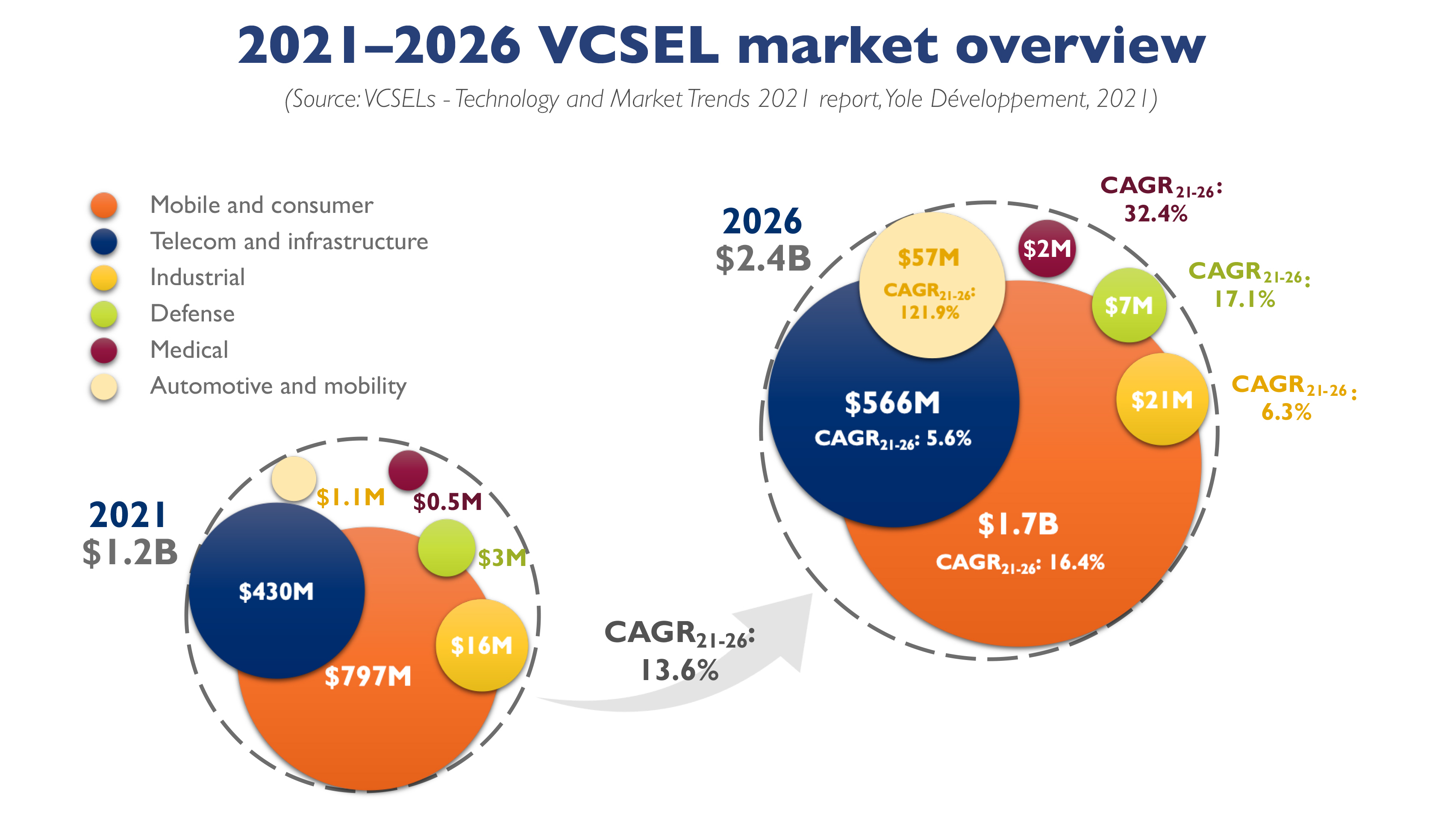VCSEL industry: all change?

VCSEL market is seeing huge technology changes and new equilibrium for industrial suppliers, says Yole
According to Yole Développement's new report VCSEL - Technology and Market Trends 2021, the global VCSEL market is expected to reach $2.4 billion in 2026 at a 13.6 percent CAGR 21-26, driven by datacom and mobile applications.
Mobile & consumer market segment is expected to grow to $1,7 billion in 2026 at a 16.4 percent CAGR21-26. VCSELs for automotive & mobility is expected to grow to $57 million in 2026, at an impressive CAGR21-26 of 122 percent.
“VCSEL technology is continuously evolving. It has already occurred in the past with the transition from 850nm-based VCSELs for datacom applications to 940nm-based VCSEL arrays for 3D sensing applications,” says Pierrick Boulay, technology & market analyst, Solid-State Lighting at Yole Développement (Yole).
He adds: “A few years ago, smartphones embedded a notch in the front display to implement the selfie camera and the face recognition module. These elements take up space and are unsightly. The goal is to hide these elements under the display. To enable this, a transition in the wavelength used for 3D sensing would be necessary for the light to penetrate the display.”
According to Boulay: "In this market, revenues linked to smartphones are expected to remain stable in 2021 and 2022. This is explained by the decreasing adoption of 3D sensing modules by Android players. In 2021, only Apple is implementing VCSELs and developing AR applications. This will create a relatively flat market for two years. Growth could be back after that with Android players".
Data communications is the second biggest market, expected to generate revenue of $430 million in 2021 and expected to reach $566 million in 2026 at a CAGR of 5.6 percent. The automotive market is quite small in 2021 with revenue of $1.1 million but is expected to reach $57 million in 2026 at a CAGR of 122 percent with applications in LiDAR and driver monitoring. Industrial applications are expected to generate revenue of $16 million in 2021 that could reach $21 million in 2026 at a CAGR of 6.3 percent.
Industrial revenue could take-off at mid-term with the emergence of applications using 3D LiDARs. These applications will be related to smart infrastructure and logistics.
It appears that OLED displays are transparent to SWIR light, around 1300 to 1400 nm. The shift from 940nm to such SWIR wavelengths will deeply impact the components and the supply chain. For 940nm, VCSELs are made from 6inch GaAs wafers. SWIR VCSELs should be based on InP , which is much more difficult to process, and manufacturing is currently done on 2inch and/or 3inch.
Business unit manager, Solid-State Lighting & Display at Yole, Pars Mukish says: “The impact is not limited to the light source but also to the receiver, where silicon-based SPADs are used in the NIR region. Silicon can no longer be used in the SWIR region. SPADs will have to have to be based on InGaAs material or using quantum dots. In both cases, the technology is still emerging, manufacturing yields are low, and availability of components is limited. This will lead to higher component costs for both the emitter and the receiver”.
Only Apple, whose smartphones have ASPs higher than $1,000, can afford such a technology change. Smartphones are not the only application where technology is evolving. Automotive applications, and LiDAR in particular, will benefit from recent developments. Multi-junction technology represents the next leap forward for the VCSEL industry. The multi-junction VCSEL offers many significant benefits to users. Multi-junction VCSELs, in a back-side emitting configuration, would have several advantages over their conventional sibling. Eliminating wire bonds would improve the VCSEL performance and allow the use of micro lenses to have more compact packages.


































